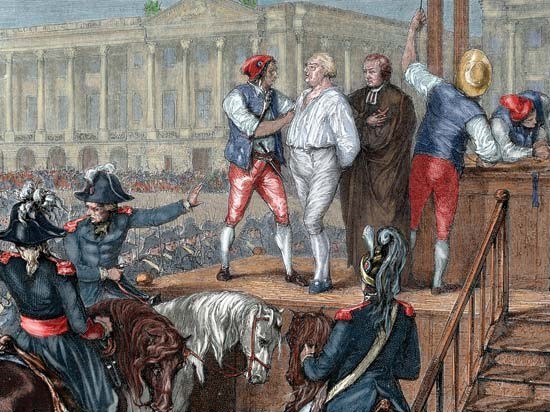Queen Guillotine
The most famous queen during the French Revolution is not human. She had only one tooth, which is large and made of iron. Her head is tall and wooden. She is the guillotine.
Ironically, she was invented in France at the request of King Louis XVI, who agrees that France should have a “humane” form of execution for its many prisoners. Before that, prisoners were tied to a wheel and their bones broken. Their agonies could last hours and even days. Birds would often peck at the victims.
During the French Revolution, 16,549 people, including clergy, scientists, and nobility, meet their end within the gruesome machine.
She is named for Dr. Joseph-Ignace Guillotin, who opposed the death penalty. In a speech, he joked about the newly invented device, and the joke caught on with the public. Later, he hid the family of one of its victims and was sent to prison. He only narrowly escaped death by his ownn inventio.
Despite supposedly being humane, it is a horrible death. The victims lie face down, hands tied at their sides, their head sticking through the crescent, the stench of others’ blood wafting up their nostrils. Below their heads, a wicker basket beckons.
Death is not always instantaneous. If the blade does not render someone unconscious, the severed head can live up to 13 seconds. Several condemned scientists have students carry out experiments. The students ask questions, and the head blinks in response.
The most famous people to be beheaded are King Louis XVI and Queen Marie Antoinette. Both go bravely to their deaths. The king refuses to be helped across the platform. And when Marie accidentally steps on the executioner’s foot as she ascends the stairs, she politely tells him she is sorry.

By contrast, Maximilien de Robespierre, the revolutionary who sent thousands to their deaths, shrieks and begs. Not that he can speak well. He tried shooting himself during his arrest, and half of his jaw is missing.
The machine silences his pleas.
Contrary to many people’s belief, the use of the guillotine did not end with the French Revolution. During World War Two, the Nazis secretly used it to kill over a thousand people. Two were a working-class couple who spread anonymous anti-Nazi postcards after their son was killed in the war. Several others were college students who were convicted of spreading anti-war pamphlets at the University of Munich.
The last known use of the guillotine is the execution of a murderer in 1981.
Indicate which of the underlined words are verbs or lesser verbs. Treat them all as verbs.
Then use a highlighter to mark them in the reading.
1. Prisoners were tied to a wheel and their bones broken. |
2. Birds would often peck at the victims. |
3. The joke catches on with the public. |
4. The victims will lie face down, the stench of others’ blood wafting up their nostrils. |
5. The head will blink in response. |
6. The most famous people to be beheaded are King Louis XVI and Queen Marie Antoinette. |
7. Maximilien de Robespierre shrieks and begs. |
8. Not that he can speak well. |
9. He tried shooting himself during his arrest. |
10. The machine silences his pleas. |